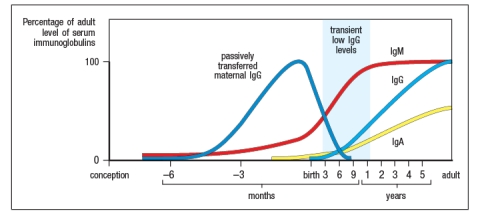Infants and young children with deficiencies in specific complement components present with recurrent respiratory infections caused by extracellular bacteria. The peak age of susceptibility is between 6 and 12 months after birth. At this time, as shown in Figure , maternal antibodies acquired by the child during fetal gestation are nearly gone, but the child is not yet generating robust antibody responses to new infections, as indicated by the low circulating levels of IgG and IgA. As children with this immunodeficiency get older, they outgrow this disease and show no further evidence of these recurrent infections. Based on this information, name one likely gene deficiency (in the complement system) that could cause this primary immunodeficiency, and the specific complement pathway likely to be affected. Explain your answer. 
Correct Answer:
Verified
Infants and small children ...
View Answer
Unlock this answer now
Get Access to more Verified Answers free of charge
Q7: Neutrophils regulate the production of active cathelicidins
Q8: The C3 convertase of the alternative complement
Q9: Although the complement cascade can be initiated
Q10: The formation of the C3 convertase is
Q11: Pathogenic infections induce damage to the host
Q13: Epithelial surfaces provide the first line of
Q14: One form of anemia results when individuals
Q15: Streptococcus pneumoniae is a Gram-positive bacterium that
Q16: Patients with recurrent infections of Neisseria meningitidis,
Q17: The classical complement pathway is initiated by
Unlock this Answer For Free Now!
View this answer and more for free by performing one of the following actions

Scan the QR code to install the App and get 2 free unlocks

Unlock quizzes for free by uploading documents